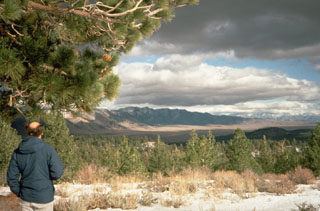Report on Long Valley (United States) — November 1982
Scientific Event Alert Network Bulletin, vol. 7, no. 11 (November 1982)
Managing Editor: Lindsay McClelland.
Long Valley (United States) No new earthquake swarms or deformation changes
Please cite this report as:
Global Volcanism Program, 1982. Report on Long Valley (United States) (McClelland, L., ed.). Scientific Event Alert Network Bulletin, 7:11. Smithsonian Institution. https://doi.org/10.5479/si.GVP.SEAN198211-323822
Long Valley
United States
37.7°N, 118.87°W; summit elev. 3390 m
All times are local (unless otherwise noted)
As of early December, no earthquake swarms had been reported in the caldera since the 3 November events. A network of nine dry tilt stations in the S part of the caldera has been reoccupied about six times since May. The sensitivity limit of this network, estimated at about 10 µrad, is too large to allow monitoring of the continuing uplift of the resurgent dome at present (1980-1982) rates. However, these tilt stations would be sensitive to substantial increases in the overall rate of resurgence, or significant local deformation, neither of which has been detected. Borehole tiltmeters installed near two of the dry tilt sites 1 November are expected to be able to measure tilt changes several times as small and will telemeter data to the USGS.
Geological Summary. The large 17 x 32 km Long Valley caldera east of the central Sierra Nevada Range formed as a result of the voluminous Bishop Tuff eruption about 760,000 years ago. Resurgent doming in the central part of the caldera occurred shortly afterwards, followed by rhyolitic eruptions from the caldera moat and the eruption of rhyodacite from outer ring fracture vents, ending about 50,000 years ago. During early resurgent doming the caldera was filled with a large lake that left strandlines on the caldera walls and the resurgent dome island; the lake eventually drained through the Owens River Gorge. The caldera remains thermally active, with many hot springs and fumaroles, and has had significant deformation, seismicity, and other unrest in recent years. The late-Pleistocene to Holocene Inyo Craters cut the NW topographic rim of the caldera, and along with Mammoth Mountain on the SW topographic rim, are west of the structural caldera and are chemically and tectonically distinct from the Long Valley magmatic system.
Information Contacts: D. Dzurisin, USGS CVO, Vancouver, WA; R. Cockerham, USGS, Menlo Park, CA.

